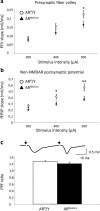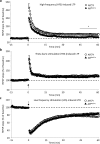Neural Androgen Receptor Deletion Impairs the Temporal Processing of Objects and Hippocampal CA1-Dependent Mechanisms
- PMID: 26849367
- PMCID: PMC4743963
- DOI: 10.1371/journal.pone.0148328
Neural Androgen Receptor Deletion Impairs the Temporal Processing of Objects and Hippocampal CA1-Dependent Mechanisms
Abstract
We studied the role of testosterone, mediated by the androgen receptor (AR), in modulating temporal order memory for visual objects. For this purpose, we used male mice lacking AR specifically in the nervous system. Control and mutant males were gonadectomized at adulthood and supplemented with equivalent amounts of testosterone in order to normalize their hormonal levels. We found that neural AR deletion selectively impaired the processing of temporal information for visual objects, without affecting classical object recognition or anxiety-like behavior and circulating corticosterone levels, which remained similar to those in control males. Thus, mutant males were unable to discriminate between the most recently seen object and previously seen objects, whereas their control littermates showed more interest in exploring previously seen objects. Because the hippocampal CA1 area has been associated with temporal memory for visual objects, we investigated whether neural AR deletion altered the functionality of this region. Electrophysiological analysis showed that neural AR deletion affected basal glutamate synaptic transmission and decreased the magnitude of N-methyl-D-aspartate receptor (NMDAR) activation and high-frequency stimulation-induced long-term potentiation. The impairment of NMDAR function was not due to changes in protein levels of receptor. These results provide the first evidence for the modulation of temporal processing of information for visual objects by androgens, via AR activation, possibly through regulation of NMDAR signaling in the CA1 area in male mice.
Conflict of interest statement
Figures






Similar articles
-
N-methyl-D-aspartate receptor-dependent long-term potentiation in CA1 region affects synaptic expression of glutamate receptor subunits and associated proteins in the whole hippocampus.Neuroscience. 2006 Sep 1;141(3):1399-413. doi: 10.1016/j.neuroscience.2006.04.070. Epub 2006 Jun 12. Neuroscience. 2006. PMID: 16766131
-
Glucocorticoid receptor activation selectively hampers N-methyl-D-aspartate receptor dependent hippocampal synaptic plasticity in vitro.Neuroscience. 2005;135(2):403-11. doi: 10.1016/j.neuroscience.2005.05.039. Neuroscience. 2005. PMID: 16125856
-
Conditional deletion of Eps8 reduces hippocampal synaptic plasticity and impairs cognitive function.Neuropharmacology. 2017 Jan;112(Pt A):113-123. doi: 10.1016/j.neuropharm.2016.07.021. Epub 2016 Jul 20. Neuropharmacology. 2017. PMID: 27450093
-
Maternal care influences hippocampal N-methyl-D-aspartate receptor function and dynamic regulation by corticosterone in adulthood.Biol Psychiatry. 2012 Sep 15;72(6):491-8. doi: 10.1016/j.biopsych.2012.03.016. Epub 2012 Apr 21. Biol Psychiatry. 2012. PMID: 22521150
-
Behavioral and neural aspects of the spatial processing of conspecifics signals in the electrosensory system.Behav Neurosci. 2019 Jun;133(3):282-296. doi: 10.1037/bne0000320. Epub 2019 May 2. Behav Neurosci. 2019. PMID: 31045393 Review.
Cited by
-
Androgen Affects the Inhibitory Avoidance Memory by Primarily Acting on Androgen Receptor in the Brain in Adolescent Male Rats.Brain Sci. 2021 Feb 14;11(2):239. doi: 10.3390/brainsci11020239. Brain Sci. 2021. PMID: 33672867 Free PMC article.
-
Adult male mice exposure to nonylphenol alters courtship vocalizations and mating.Sci Rep. 2018 Feb 14;8(1):2988. doi: 10.1038/s41598-018-21245-9. Sci Rep. 2018. PMID: 29445187 Free PMC article.
-
Effects of Oral Contraceptive Androgenicity on Visuospatial and Social-Emotional Cognition: A Prospective Observational Trial.Brain Sci. 2020 Mar 25;10(4):194. doi: 10.3390/brainsci10040194. Brain Sci. 2020. PMID: 32218215 Free PMC article.
-
Quantifying observational evidence for risk of dementia following androgen deprivation therapy for prostate cancer: an updated systematic review and meta-analysis.Prostate Cancer Prostatic Dis. 2021 Mar;24(1):15-23. doi: 10.1038/s41391-020-00267-3. Epub 2020 Aug 19. Prostate Cancer Prostatic Dis. 2021. PMID: 32814845
-
PCR-based profiling of transcription factor activity in vivo by a virus-based reporter battery.iScience. 2022 Feb 14;25(3):103927. doi: 10.1016/j.isci.2022.103927. eCollection 2022 Mar 18. iScience. 2022. PMID: 35281741 Free PMC article.
References
-
- Galea LAM, Uban KA, Epp JR, Brummelte S, Barha CK, Wilson WL, et al. Endocrine regulation of cognition and neuroplasticity: our pursuit to unveil the complex interaction between hormones, the brain, and behaviour. Can J Exp Psychol Rev Can Psychol Expérimentale. 2008; 62: 247–260. 10.1037/a0014501 - DOI - PubMed
-
- Howell S, Shalet S. Testosterone deficiency and replacement. Horm Res. 2001; 56 Suppl 1: 86–92. - PubMed
-
- Lamberts SW, van den Beld AW, van der Lely AJ. The endocrinology of aging. Science. 1997; 278: 419–424. - PubMed
Publication types
MeSH terms
Substances
LinkOut - more resources
Full Text Sources
Other Literature Sources
Molecular Biology Databases
Research Materials
Miscellaneous

